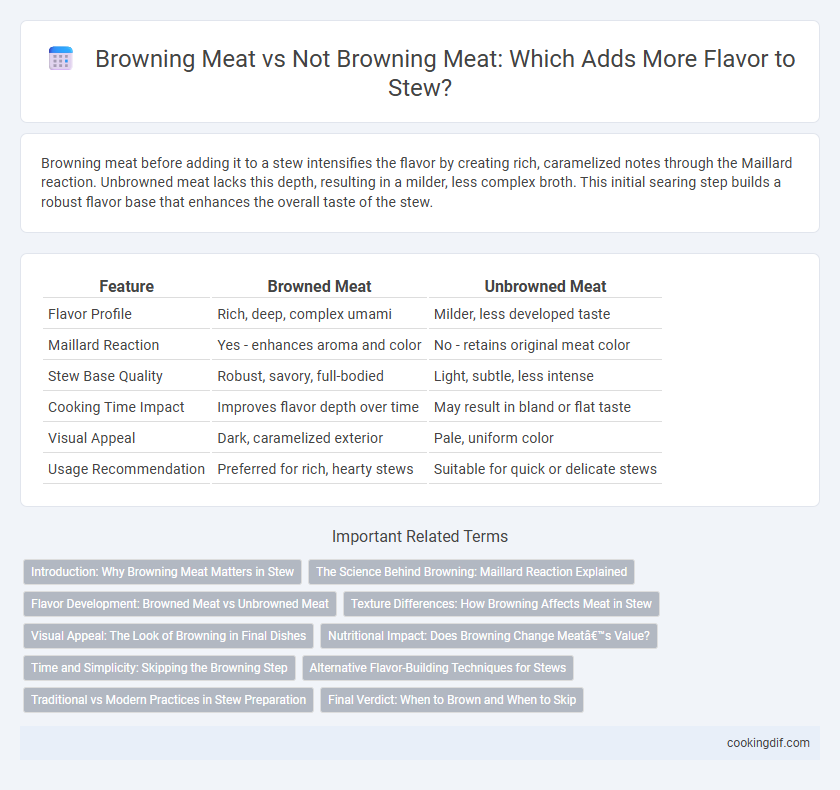Browning meat before adding it to a stew intensifies the flavor by creating rich, caramelized notes through the Maillard reaction. Unbrowned meat lacks this depth, resulting in a milder, less complex broth. This initial searing step builds a robust flavor base that enhances the overall taste of the stew.
Table of Comparison
| Feature | Browned Meat | Unbrowned Meat |
|---|---|---|
| Flavor Profile | Rich, deep, complex umami | Milder, less developed taste |
| Maillard Reaction | Yes - enhances aroma and color | No - retains original meat color |
| Stew Base Quality | Robust, savory, full-bodied | Light, subtle, less intense |
| Cooking Time Impact | Improves flavor depth over time | May result in bland or flat taste |
| Visual Appeal | Dark, caramelized exterior | Pale, uniform color |
| Usage Recommendation | Preferred for rich, hearty stews | Suitable for quick or delicate stews |
Introduction: Why Browning Meat Matters in Stew
Browning meat in stew develops complex flavors through the Maillard reaction, which caramelizes natural sugars and proteins, creating a rich, deep taste that unbrowned meat lacks. This process enhances the stew's overall aroma and mouthfeel, making each bite more savory and satisfying. Skipping browning results in a milder, less flavorful broth that can make the dish taste flat and less hearty.
The Science Behind Browning: Maillard Reaction Explained
The Maillard reaction, a complex chemical process occurring between amino acids and reducing sugars, is crucial for developing the rich, savory flavors in browned meat during stew preparation. This reaction enhances the depth and complexity of the flavor base by producing hundreds of flavorful compounds that are absent in unbrowned meat. Skipping the browning step in stew results in a less robust taste profile, as unbrowned meat lacks the Maillard-derived flavor molecules essential for a deeply aromatic and satisfying dish.
Flavor Development: Browned Meat vs Unbrowned Meat
Browning meat initiates the Maillard reaction, enhancing flavor complexity through the development of rich, caramelized notes and deep umami characteristics. Unbrowned meat lacks these intensified flavors, resulting in a stew with a milder, less robust taste profile. Using browned meat as a flavor base significantly elevates the stew's depth and overall savoriness.
Texture Differences: How Browning Affects Meat in Stew
Browning meat before adding it to stew enhances texture by creating a caramelized crust that locks in juices, resulting in a firmer, more flavorful bite. Unbrowned meat tends to release more moisture during cooking, leading to a softer, sometimes mushier consistency that lacks the depth of texture achieved through browning. This Maillard reaction not only develops complex flavors but also improves the overall mouthfeel of the stew.
Visual Appeal: The Look of Browning in Final Dishes
Browning meat before adding it to a stew creates a rich, caramelized crust that enhances the dish's visual appeal with deep, appetizing color contrasts. Unbrowned meat lacks this Maillard reaction, resulting in a paler, less visually dynamic stew that may appear less flavorful. The golden-brown exterior of browned meat signals depth of flavor and expertly crafted texture, elevating the overall presentation of the final dish.
Nutritional Impact: Does Browning Change Meat’s Value?
Browning meat in stew enhances flavor through the Maillard reaction, creating complex compounds that improve taste but has minimal effect on the meat's core nutritional profile. Studies show browned meat retains essential proteins, vitamins like B12, and minerals such as iron, with only slight nutrient loss from heat exposure. The primary nutritional impact is slight fat oxidation, which can be minimized by proper cooking techniques, ensuring browned meat remains a nutrient-dense flavor base for stews.
Time and Simplicity: Skipping the Browning Step
Skipping the browning step in stew preparation saves significant time and simplifies the cooking process. While unbrowned meat may result in a milder flavor profile, longer simmering enhances tenderness without the robust caramelized notes. Choosing unbrowned meat streamlines the recipe for quick, easy meals without compromising overall stew quality.
Alternative Flavor-Building Techniques for Stews
Browning meat chemically enhances flavor through the Maillard reaction, producing rich, complex taste profiles vital for traditional stew bases. Alternative techniques like roasting vegetables, using umami-rich ingredients such as mushrooms or soy sauce, and deglazing pans with wine or broth can build depth without browning meat. Incorporating ingredients like tomato paste and slow-simmering aromatics also layers savory intensity while offering varied flavor dimensions.
Traditional vs Modern Practices in Stew Preparation
Traditional stew preparation emphasizes browning meat to develop deep, rich flavors through the Maillard reaction, enhancing the savory base and creating complex taste profiles. Modern practices sometimes skip browning, focusing on simplicity and time efficiency, which results in a lighter, less intense flavor but retains the meat's natural juiciness. Understanding the balance between browning and unbrowned meat allows cooks to tailor stew complexity and texture according to desired culinary outcomes.
Final Verdict: When to Brown and When to Skip
Browning meat before adding it to stew creates a rich Maillard reaction that intensifies flavor and enhances the overall depth of the dish. Skipping browning can save time and retain a lighter, cleaner meat taste, useful in delicate broths or quick-cooking recipes. Choose to brown tougher cuts like chuck or brisket for hearty stews, while skipping it for tender cuts or when a purer, less robust flavor is desired.
Browned meat vs unbrowned meat for flavor base Infographic

 cookingdif.com
cookingdif.com